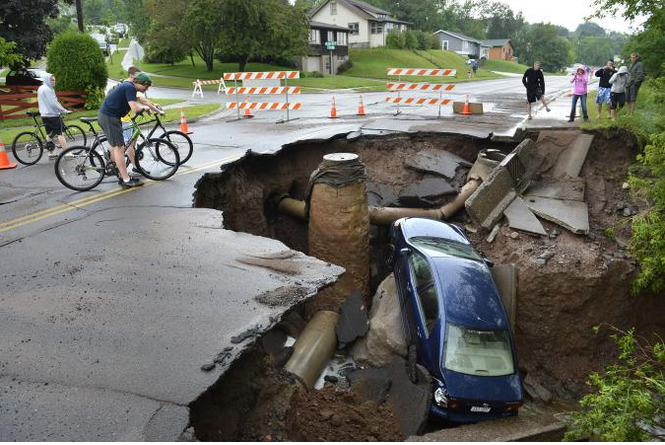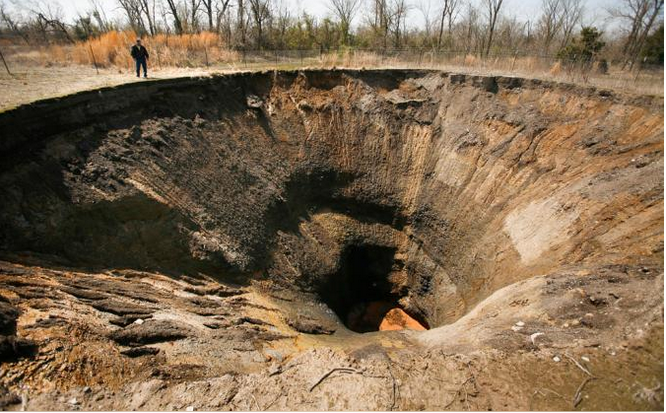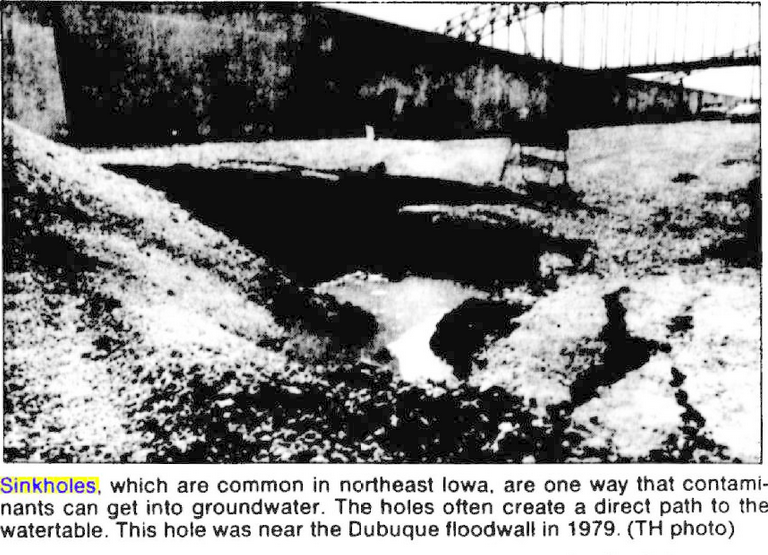Encyclopedia Dubuque
"Encyclopedia Dubuque is the online authority for all things Dubuque, written by the people who know the city best.”
Marshall Cohen—researcher and producer, CNN
Affiliated with the Local History Network of the State Historical Society of Iowa, and the Iowa Museum Association.
SINKHOLES


SINKHOLES. Two types of sinkholes exist. One forms when the roof of a cave collapses and exposes the underground cavern. The second type forms when water dissolves the rock underneath soil and creates an underground chasm. Without rock to support it, the soil layer collapses and creates a hole on the surface. (1)
In 1987 a home on Crissy Drive had a sinkhole appear in the front yard. The 10 X 12 foot diameter hole was filled with six-inch rock on a Saturday but reappeared the following day. Its original diameter remained the same, but the bottom diameter had increased to 19 feet. On Monday the hole was filled with truckloads of 200-300 pound rocks which were expected to solve the problem. Assistant City Engineer Ernie Roarig described the sinkhole as one of the largest three he had ever seen during his thirty-four years with the city. It was believed the sinkhole had been caused by the ground above giving way into an abandoned mine shaft. (2) In 2011 heavy rain created the conditions to cause two sinkholes to appear in the yard of a Telegraph Herald reporter. It required twenty-three tons of rock to fill them. (3)
The occurrence on Crissy would not have surprised retired university professor and geologist Jim Dockal. Well-known in Dubuque, Dockal in 2014 expressed his belief that there were as many as 500 and possible 1,000 mine shafts and tunnels beneath the city. Often these were not filled in or closed up properly. Some were used for the disposal of yard waste which would decay. Nineteenth century miners were not record keepers. Very records of mine shafts were made. City Engineer Gus Psihoyos explained that sinkholes occur in right-of-ways several times annually. Efforts were then made to stabilize the area and repair damage to utilities. (4) Those affected by sinkholes have suggested homeowners should be able to purchase insurance for sinkhole-related damages. Some state legislatures have mandated such risk pools, but as of 2014 nothing had been enacted in Iowa.
The valley of the MISSISSIPPI RIVER lies over a large arch of stone called the "Mississippi Arch." If EARTHQUAKES occur, tremors would be carried up the valley. Limestone layers that create networks of caves and sinkholes in the area would probably collapse during a major event. (5)
---
Source:
1. "Sinkholes," National Geographic, Online: https://www.nationalgeographic.com/environment/sinkhole/
2. Kirchen, Rich, "Sinkhole Stops Growing," Telegraph Herald, October 28, 1987, p. 3
3. Editorial, Telegraph Herald, August 2, 2011, p. 4
4. Jacobson, Ben, "Not Going Down Without a Fight," Telegraph Herald, April 21, 2014, p. 1A
5. Breyfogle, Bill, "Major Earthquake Would Be Felt in Dubuque Area," Telegraph Herald, January 9, 1983, p. 18


